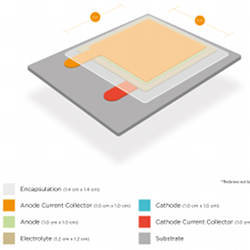
The bulky, flammable, liquid-core rechargeable lithium-ion (Li-Ion) batteries of today will be made obsolete by solid-state batteries, according to the co-inventor of today's Li-Ion batteries, John Goodenough, professor in the Cockrell School of Engineering at the University of Texas at Austin (UTA).
Earlier this year, Goodenough and his team published a paper in the journal Energy and Environmental Science detailing their demonstration of a low-cost, non-combustible solid-state battery; instead of liquid electrolytes, the battery uses glass electrolytes.
Said Jim McGregor, principle analyst at advisory firm Tirias Research, Mesa, AZ, "Lithium-ion batteries are not a long-term solution. We need better, safer, lighter, and less-expensive solutions, especially for the IoT [Internet of Things] market to take off."
McGregor said the solid-state batteries produced by Southampton, U.K.-based materials innovation firm Ilika PLC "are impressive, especially for small devices such as sensors, although they say they are also working on larger-scale solid-state batteries [with Toyota]." He said the batteries are well suited for Internet of Things (IoT) devices because "they are rugged and can harvest solar or vibrational energy to keep them constantly recharged. And for one-use applications, such as medical sensors a patient wears for a week to monitor his heart, they are inexpensive enough that they could be charged once and thrown away after the patient returns the monitor to the doctor—eliminating the need for re-sterilization."
McGregor added that Ilika's solid-state batteries will work well with super-low-power radio transmitters just now becoming available for IoT installations. "The low-power radio is going to finally make the machine-to-machine IoT market take off, from industrial infrastructure sensors such as those monitoring a bridge's health, to consumer wearables for everything from fashion to the invisible monitoring of health and exercise."
In addition to Ilika, organizations independently developing solid-state batteries include Cymbet Corp. (Elk River, MN), Solid Power (Louisville, CO), and UTA, which is licensing Goodenough's architecture for a solid-state Li-Ion battery to power-cell manufacturers.
Cymbet specializes in replacing Li-Ion coin batteries and supercapacitors on printed circuit boards with solid-state units one-tenth the size that last three times longer. They also are used in power-harvesting applications, such as paired with a solar cell to power a remote sensor at night or on rainy days when the sun is not shining.
Ilika's solid-state batteries, on the other hand, are designed for applications such as powering an IoT device indefinitely using energy harvesting of vibrations or with solar cells. Solid Power's solid-state batteries combine a high-capacity cathode with a high-capacity lithium metal anode with a high ionic conductivity solid electrolyte for applications including battery-powered portable electronics, electric vehicles, aircraft, and satellites.
Other solid-state battery makers have been snapped up by original equipment manufacturers wishing to have their own proprietary source of solid-state batteries. Apple acquired Infinite Power Solutions (Littleton, CO), a maker of thin-film and solid-state batteries, in 2013. Sakti3 (Ann Arbor, MI), a spinout of the University of Michigan, was acquired by Dyson in 2015 for its solid-state batteries, which can power the company's hand-held vacuum cleaners. Seeo Inc. (Hayward, CA) was bought by Bosch in 2015 for its solid-state state battery technology to be used in both automotive and consumer applications.
Ilika's patented solid-state Stereax battery technology initially was marketed solely for livestock tracking devices (which, for example, will open barn doors when cattle approach to let them in for milking/out for grazing). The company recently announced a ruggedized version with an extended temperature operating range ( -40o to 150o C/-40 to 302o F) designed for automotive and industrial IoT applications. According to Purdy, the new batteries are also targeted at on-board sensors, since they can harvest vibrations to recharge. He adds, "The real savings in automobiles will be in wiring, which has become a major problem with cars using hundreds of sensors; with energy harvesting and wireless radios for each sensor, the cost and size of wiring harnesses in cars can be drastically reduced."
The extended temperature range also makes the batteries suitable for aerospace applications where sensors need to operate in harsh environments. Likewise, infrastructure monitoring needs a lot of sensors in hard-to-reach places, and, for example, you don't want to send people to the top of the Golden Gate Bridge just to replace a sensor's battery, when solar energy-harvesting solid-state batteries are available, according to Purdy.
Cymbet says its EnerChip thin-film rechargeable solid-state batteries are packaged using surface mount technology, so they are as easy to use as lithium coin cells or supercapacitors. The company says the EnerChip solid-state batteries work well for backup power to maintain microcontroller settings, real-time-clock times, and even SRAM memory values during power failures ranging from a few hours to several weeks. They also can be constantly recharged via energy harvesting microelectronics.
Solid Power says it uses 100% inorganic materials in its solid-state batteries, which do not degrade over time, are not flammable, and provide double to triple the energy of conventional lithium-ion batteries. They also cost less, the company says, because they do not have to incorporate the expensive safety features required to make traditional lithium-ion batteries safe.
R. Colin Johnson is a Kyoto Prize Fellow who has worked as a technology journalist for two decades.



Join the Discussion (0)
Become a Member or Sign In to Post a Comment